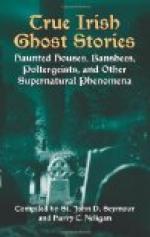Throughout the pages of this book we have, in general, avoided offering explanations of, or theories to account for, the different stories. Here something may be said on this point. As we have already pointed out, the expression “ghost stories” covers a multitude of different phenomena. Many of these may be explained as “hallucinations,” which does not imply that they are simply the effect of imagination and nothing more. “The mind receives the hallucination as if it came through the channels of sense, and accordingly externalises the impression, seeking its source in the world outside itself, whereas in all hallucinations the source is within the mind, and is not derived from an impression received through the recognised organ of sense.[15]”
[Footnote 15: Prof. Sir W. Barren, Psychical Research, p. 111.]
Many of these hallucinations are termed “veridical”, or truth-telling, because they coincide with real events occurring to another person. Illustrations of this will be found in Chapter VI, from which it would appear that a dying person (though the power is not necessarily confined to such) occasionally has the faculty of telepathically communicating with another; the latter receives the impression, and externalises it, and so “sees a ghost,” to use the popular expression. Some hallucinations are auditory i.e. sounds are heard which apparently do not correspond to any objective reality. Incomprehensible though it may appear, it may be possible for sounds, and very loud ones too, to be heard by one or more persons, the said sounds being purely hallucinatory, and not causing any disturbance in the atmosphere.
Some of the incidents may be explained as due to telepathy, that mysterious power by which mind can communicate with mind, though what telepathy is, or through what medium it is propagated, no one can tell as yet. Belief in this force is increasing, because, as Professor Sir W. Barrett remarks: “Hostility to a new idea arises largely from its being unrelated to existing knowledge,” and, as telepathy seems to the ordinary person to be analogous to wireless telegraphy, it is therefore accepted, or at least not laughed at, though how far the analogy really holds good is not at all certain.
Again there is the question of haunted houses and places, to accounts of which the first five chapters of this book are devoted. The actual evidence for many of these may not come up to the rigorous standard set by the S.P.R., but it is beyond all doubt that persons who are neither fools, liars, nor drunkards firmly believe that they have seen and heard the things related in these chapters (not to speak of Chapters VI-VIII), or that they have been told such by those in whose statements they place implicit confidence; while so certain are they that they are telling the truth that they have not only written down the stories for the compilers, but have given their names and addresses as well, though not always for publication. Can we contemptuously fling aside such a weight of evidence as unworthy of even a cursory examination? This would hardly be a rational attitude to adopt. Various theories to account for these strange hauntings have been formulated, which may be found on pp. 199-200 of Sir William Barrett’s Psychical Research, and so need not be given here.




